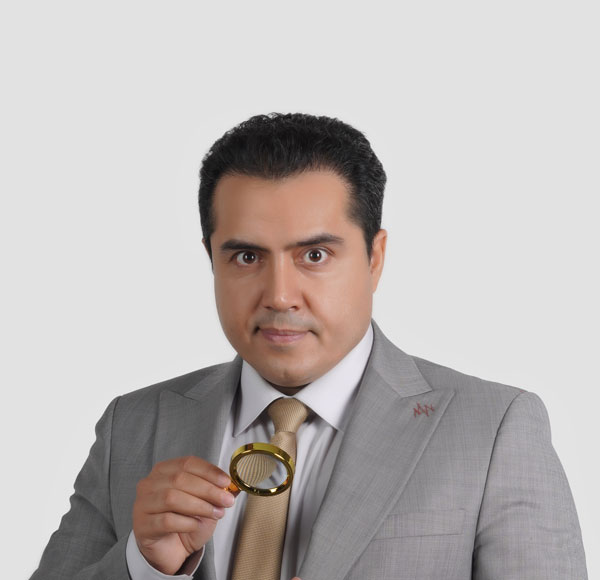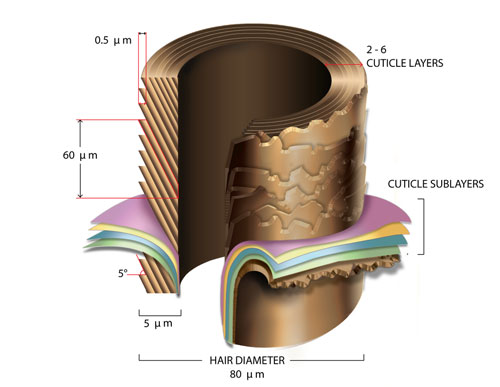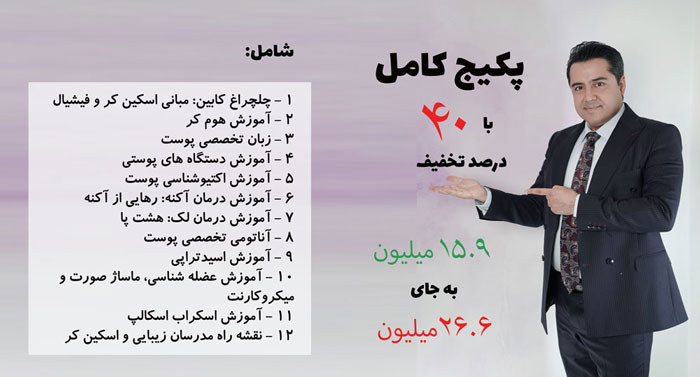کوتیکول مو چیست؟
نویسنده:
چکیده: بیرونی ترین لایه ساقه مو کوتیکول است. حدود 10 درصد از وزن مو را کوتیکول تشکیل می دهد.
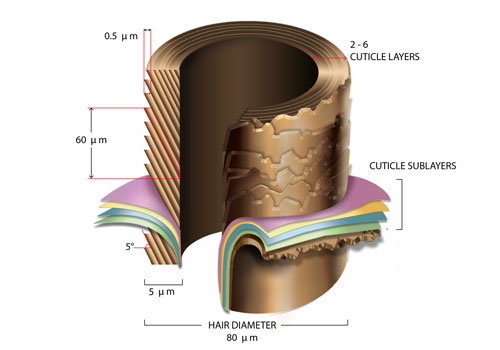
کوتیکول در واقع خارجی ترین بخش ساقه مو است. وضعیت کلی مو تا حد زیادی به وضعیت کوتیکول مو ارتباط دارد. عامل کشسانی و انعطاف مو لایه کوتیکول است. این لایه، مهمترین و مؤثرترین بخش ساقه مو را تشکیل می دهد. همچنین 10 درصد وزن مو را کوتیکول تشکیل می دهد. مهمترین لایه حفاظتی مو در برابر تنش های مکانیکی و مقاوم ترین ناحیه نسبت به ترکیبات مختلف شیمیایی است. کوچکترین آسیب یا ضایعه کوتیکول سبب خشن شدن، زبری و خشکی مو می گردد که می تواند آسیب های بیشتری را به دنبال داشته باشد.
خارجی ترین بخش ساقه مو را کوتیکول می نامند. این لایه مهم ترین و موثرترین بخش از ساقه مو را تشکیل می دهد. حدود 10 درصد از وزن مو را کوتیکول تشکیل می دهد. این لایه مهم ترین لایه حفاظتی مو در برابر تنش های مکانیکی است. این بخش از مو مقاوم ترین ناحیه نسبت به ترکیبات مختلف شیمیایی است. کوچک-ترین آسیب یا ضایعه به این طبقه سبب خشن شدن، زیری و خشکی مو می گردد که می تواند آسیب های بیشتری را به دنبال داشته باشد.
این لیوان های کاغذی یا فنجان ها بر روی هم قرار گرفته اند به گونه ای که بخش عمده هر فنجان در داخل فنجان بعدی قرار گرفته است. در هر سطح مقطع بین 7 تا 10 از این فنجان های فرضی قرار دارد. این ساختار از ریشه مو تا نوک مو امتداد دارد. هر فنجان فرضی حدود 60 میکرومتر طول و 0.5 میکرومتر ضخامت دارد. این لایه های فنجانی شکل با زاویه کم حدود 5 درجه بر روی هم چیده شده اند و حدود 5 میکرومتر از هر لایه بیرون از فنجان های زیرین می باشد.
ضخامت هر لایه حدود 0.5 میکرومتر است و در هر برش عرضی ساقه مو، کوتیکول ضخامتی حدود 5 میکرومتر دارد. اعمال تنش فیزیکی بر سطح مو مانند برس زدن، شانه کردن، حوله زدن، استفاده از روش های آرایش آسیب رسان (مانند شانه داغ)، سبب می گردد تا سطح آزاد هر لایه آسیب ببیند و این امر باعث می شود به تدریج سطح مو از کوتیکول عریان شود و لایه های زیرین که مقاومت کمتری نسبت به تنش های فیزیکی دارند، در معرض محیط قرار گیرد. این حالت به تدریج آسیب های جدی تری را برای ساقه مو به دنبال خواهد داشت.
هر لایه کوتیکول خود متشکل از شش لایه مختلف می باشد که از خارج به داخل عبارتست از:
1. سطح مو (hair surface) این بخش از کوتیکول خارجی ترین بخش کوتیکول است که در معرض محیط می باشد.
2. اپی کوتیکول (Epicuticle) این لایه بسیار نازک است و ضخامتی حدود 70-50 انگستروم دارد. این بخش ساختار پروتئینی دارد که با یک لایه چربی، که با اتصالات تیواستر به صورت کووالانس به این بخش پروتئینی واکنش داده است، چسبیده است. اصلی ترین مواد تشکیل دهنده این لایه چربی اسیدهای چرب، همراه با 18 – متیل ایکوزانوئیک اسید است. این لایه نقش مهمی را در بیان ویژگی های فیزیکی و شیمیایی مو و بروز ویژگی های سطح مو ایفا می کند.
3. لایه A (A layer) لایه A محکم ترین بخش از کوتیکول می باشد. کراتین موجود در این لایه غنی از اسید آمینه سیستئین می باشد (حدود 30%) که امکان ایجاد پل های عرضی دی سولفید در بین رشته های کراتین و استحکام بیشتر آن را سبب می شود، که در ادامه بحث به آن پرداخته خواهد شد.
4. کوتیکول خارجی (exocuticle) در این لایه میزان اسید آمینه سیستئین کمتر از لایه A می باشد (حدود 15%) که همین امر سبب کاهش استحکام آن می گردد.
5. کوتیکول داخلی (endocuticle) استحکام این لایه از لایه قبلی نیز کمتر است.
6. کمپلکس غشاء سلولی (cell membrane complex) حد واسط هر لایه از کوتیکول با لایه بعی یک لایه پیچیده می باشد که این لایه ها را به هم متصل می سازد. کمپلکس غشاء سلولی از سه بخش تشکیل شده است لایه میانی یا لایه دلتا (δ-layer) که از دو طرف با دو لایه دارای چربی به نام لایه بتا (β-layer) احاطه شده است. لایه دلتا دارای ساختاری پلی ساکاریدی با کمی پروتئین می باشد.
Hair Damage – Causes and Remedies
Weblog of Dr ALI N. SYED, The Science of Hair Care
1. سطح مو (hair surface) این بخش از کوتیکول خارجی ترین بخش کوتیکول است که در معرض محیط می باشد.
2. اپی کوتیکول (Epicuticle) این لایه بسیار نازک است و ضخامتی حدود 70-50 انگستروم دارد. این بخش ساختار پروتئینی دارد که با یک لایه چربی، که با اتصالات تیواستر به صورت کووالانس به این بخش پروتئینی واکنش داده است، چسبیده است. اصلی ترین مواد تشکیل دهنده این لایه چربی اسیدهای چرب، همراه با 18 – متیل ایکوزانوئیک اسید است. این لایه نقش مهمی را در بیان ویژگی های فیزیکی و شیمیایی مو و بروز ویژگی های سطح مو ایفا می کند.
3. لایه A (A layer) لایه A محکم ترین بخش از کوتیکول می باشد. کراتین موجود در این لایه غنی از اسید آمینه سیستئین می باشد (حدود 30%) که امکان ایجاد پل های عرضی دی سولفید در بین رشته های کراتین و استحکام بیشتر آن را سبب می شود، که در ادامه بحث به آن پرداخته خواهد شد.
4. کوتیکول خارجی (exocuticle) در این لایه میزان اسید آمینه سیستئین کمتر از لایه A می باشد (حدود 15%) که همین امر سبب کاهش استحکام آن می گردد.
5. کوتیکول داخلی (endocuticle) استحکام این لایه از لایه قبلی نیز کمتر است.
6. کمپلکس غشاء سلولی (cell membrane complex) حد واسط هر لایه از کوتیکول با لایه بعی یک لایه پیچیده می باشد که این لایه ها را به هم متصل می سازد. کمپلکس غشاء سلولی از سه بخش تشکیل شده است لایه میانی یا لایه دلتا (δ-layer) که از دو طرف با دو لایه دارای چربی به نام لایه بتا (β-layer) احاطه شده است. لایه دلتا دارای ساختاری پلی ساکاریدی با کمی پروتئین می باشد.
در مورد کوتیکول مو بیتشر مطالعه کنیم:
Hair Damage – Causes and Remedies
Weblog of Dr ALI N. SYED, The Science of Hair Care

کوتیکول های مو شباهت زیادی به لیوان های کاغذی دارد که روی همدیگر قرار گرفته اند.
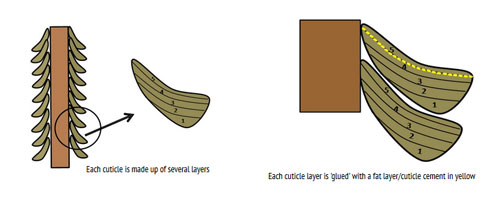
هر کوتیکول خود از لایه های متعددی تشکیل شده است.

مقایسه ابعاد قطر خارجی مو و لایه کوتیکول. اگر قطر خارجی مو 80 میکرومتر باشد، قطر لایه کوتیکول که خارجی ترین لایه مو می باشد 5 میکرومتر خواهد بود
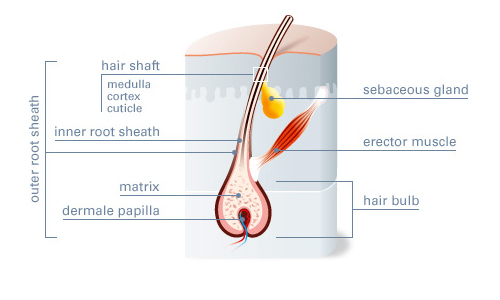
درمال پاپیلا، ماتریس مو، پیاز مو، ماهیچه راست کننده مو، غدد سباسه یا سبابه، شافت مو شامل مدولا، کورتکس و کوتیکول و همچنین ریشه داخلی غلاف مو و ریشه خارجی غلاف مو در این شکل نشان داده شده است.

پروسه رنگ شدن مو توسط رنگ مو: رنگ موهای شیمیایی و دائمی از کوتیکول عبور نموده، به داخل محور مو نفوذ می کنند و اثربخشی آن ها طولانی مدت است. یعنی برای مدت طولانی تری رنگ مو روی مو باقی می ماند.

انواع مختلف کوتیکول مو زیر میکروسکوپ
لایه های مو از بیرونی ترین لایه به داخلی ترین لایه عبارتند از کوتیکول، کورتکس و مدولا

در رنگ موهای موقتی، مولکول های رنگ از کوتیکول مو عبور نمی کند.
ساختار ناخن شامل کناره ناخن یا لبه ناخن، ناخن بخش بسیار کراتینیزه شده پوست است و از ضمایم پوست به شمار می آید. به علت عدم وجود رنگدانه، شفاف است. ریشه ناخن در داخل پوست قرار گرفته است. ماتریکس ناخن، ریشه ناخن، چین پروکسیمال ناخن، کوتیکول ناخن، بدنه ناخن، بستر ناخن، لبه آزاد ناخن، استخوان انگشت در این شکل دیده می شوند.
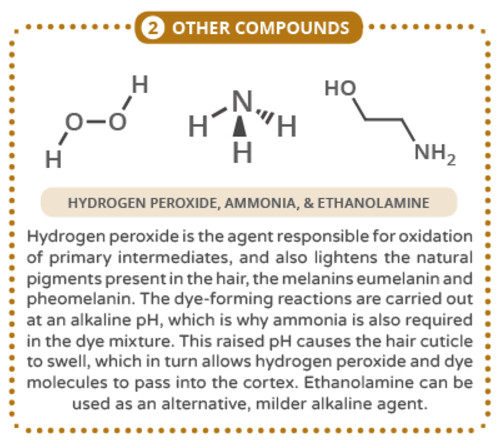
هیدروژن پروکسید، ماده ای است که مسئول اکسیداسیون مواد واسطه اولیه میباشد. این ماده همچنین رنگ طبیعی مو را روشن میکند و باعث از بین رفتن رنگ طبیعی مو (یوملانین و فائوملانین) میشود. واکنش های تشکیل دهنده رنگ در یک محیط قلیایی (با pH بالا) انجام میشود. به همین دلیل آمونیاک به فرمولاسیون رنگ مو اضافه میشود. این pH بالا رفته یا محیط قلیایی باعث میشود کوتیکول های مو متورم شده و باز شود. به این ترتیب، هیدروژن پرکسید و مولکول های رنگ میتواند وارد ساختار مو شده و از کوتیکول عبور نموده، وارد کورتکس شود. اتانول آمین میتواند به عنوان جایگزین استفاده شود تا محیط قلیایی ملایم تری ایجاد کند.
,-paronychium-(edge),-and-hyponychium.jpg)
ساختار ناخن در این شکل نشان داده می شود. ناخن شش قسمت اصلی دارد که عبارت است از: ریشه ناخن، بستر ناخن، بدنه ناخن، کوتیکول ناخن، لبه ناخن و هیپونسیوم. ماتریس ناخن ریشه ناخن را می سازد. ریشه ناخن رشد می کند و به بدنه ناخن تبدیل می شود.
• Cuticle
English: specially developed in farmasi laboratories nail polish remover quickly and gently removes varnish promoting strong, healthy-looking nails and cuticles every time you use it. its enriched with rose water and vitamin e extract formula moisturizes dry, brittle nails. jojoba oil keeps nails strong and healhty-looking.
ترجمه به فارسی: لاک پاک کن ناخن که به صورت انحصاری و خاص در آزمایشگاه های فارماسی طراحی و تولید شده، مواد لعابی لاک ناخن را به سرعت و با ملایمت پاک می کند و به مرور زمان موجب افزایش استحکام و سلامت ناخن ها و کوتیکول آن ها می شود. فرمولاسیون این لاک پاک کن غنی از عصاره گل رز و ویتامین E بوده و موجب رطوبت رسانی ناخن های خشک و شکننده می شود. روغن جوجوبا، ناخن ها را محکم و شاداب نگاه می دارد.English: tea tree balm, enriched with natural tea tree oil formula, soothes your skin while creating a protective barrier over it. applicable for lips, face, cuticles and other dry and rough areas of the skin.
ترجمه به فارسی: بالم درخت چای غنی از روغن درخت چای می باشد. تسکین دهنده پوست بوده و روی پوست لایه ای محافظ تشکیل می دهد. قابل استفاده روی لب ها، صورت، کوتیکول و بخش های خشک و زبرشده پوست.
ARGANIA SPINOSA — Argan Oil. Nutrient-rich oil, high in essential fatty acids and antioxidant vitamin E. Supports the skin’s collagen and improves softness and elasticity. In hair care products, it rehydrates and smoothes the hair cuticle to help reduce frizzing and add shine. (INCI dictionary)
CHENOPODIUM QUINOA — Quinoa Protein. One of the most complete plant proteins, high in vitamins, minerals and the sulfur- containing amino acids cystine and cysteine, excellent nutrients for the hair, scalp and skin. A fixative in hair styling products, it smoothes layers in the hair’s cuticle to strengthen hair fiber, reduce frizzing and enhance shine. Used in anti-aging creams and facial masks, it firms and nourishes the skin for a more youthful appearance. CHLORELLA PYRENOIDOSA — Chlorella. Made up of over 60% protein, this green micro-algae contains all the essential amino acids, and is high in chlorophyll and vitamin B. An excellent nutrient, often used as a skin hydrator. (INCI dictionary)
CITRUS SINENSIS — Orange Pith Juice.The plant liquid squeezed from the pith and peel of oranges after they have been juiced. High in vitamin C and pectinic acid, it helps smooth the cuticle of the hair to lock in nutrients and enhance shine. (INCI dictionary)
HYDROLYZED KERATIN — A combination of complex proteins, keratin is the key structural component of the hair, making up about 90% of healthy hair fiber. Used in hair products, it bonds to individual strands and forms a protective coating that helps seal in moisture and nutrients and smoothes the hair cuticle to reduce frizzing and add shine. (INCI dictionary)
PECTIN — Obtained from the cell walls of plants, the peel of citrus and the crushed pulp of apples. Used in hair care products, it helps smooth the cuticle to lock in nutrients and enhance shine. PELARGONIUM GRAVEOLENS — Geranium Oil. Essential oil with astringent and tonic proper ties, an excellent normalizer foroily skin. Sometimes used as a fragrance. (INCI dictionary)
Bleach Activator: Bleach activator is generally hydrogen peroxide and it's needed to open the hair cuticle to allow the bleaching agent inside the hair shaft. It also chemically reacts with the bleach to de-colorize pigments. The higher the volume of peroxide (activator) used, the faster and lighter the hair becomes- but the more damaged it can get too. (thehairstyler.com)
Cortex: The cortex lies directly underneath the cuticle and is spiral-looking in appearance- kind of like a coiled rope. It's here that pigments are found and that natural hair elasticity, i.e. straight, wavy, curly, gets its form. The cortex is also where all permanent chemical coloring takes place, including bleaching, perming and chemical straightening, and where the natural shape of the hair is changed; for example, using hot irons to go from curly to straight or hot rollers to go from straight to curly. These changes last only until the hair becomes wet again. (thehairstyler.com)
Cuticle: The cuticle is the outermost structure of the hair, resembling fish scales packed down up to 12 rows deep. The cuticle is the hair's first defence against all forms of damage that include chemicals, ultra-violet light, styling appliances, styling products etc. A damaged cuticle leaves the hair looking dull and feeling rough, but more importantly, increases the likelihood of extreme damage occurring inside (leading to things such as natural and artificial color fade, split ends and breakage). (thehairstyler.com)
Demi-Permanent Color: A demi-permanent is a wash-out color that lasts around 20-25 shampoos. Demi-permanents do have low levels of hydrogen peroxide in them to open the cuticle and allow the color inside the hair shaft. This type of color is great for going darker, brighter, adding shine and for hiding and blending small amounts of grey. However, although demi-permanents will not lighten hair like permanent color, caution should taken because with prolonged use color build up in the hair results in the color not washing away, making it permanent in nature and leading to regrowth problems. (thehairstyler.com)
Permanent Hair Color: A permanent hair color employs chemicals to artificially change, delete, or counteract the natural pigment in the cortex layer of the hair shaft. This is done when dyes and bleaches are turned on by mixing them with an activator (generally peroxide) and sometimes heat, to open the cuticle and then allow the chemical changes to take place. The results are permanent changes that do not revert back to the original, however the roots of the hair grow back unchanged (regrowth). (thehairstyler.com)
Peroxide: Peroxide is otherwise known as hydrogen peroxide and is used in many ways in everyday life as a bleaching agent, disinfectant, oxidizer and antiseptic, but it's extensively used in hair color services as a developer or activator. Its primary role is to open the cuticle layer and allow tints or bleach into the cortex so they can then deposit or remove color by breaking disulfide bonds within the hair, releasing sulfur (hence the smell). When peroxide is mixed with hair bleach, the peroxide continues to de-colorize color pigments; but when mixed with tints, its role is to bond the new color molecule inside the hair. (thehairstyler.com)
Semi-Permanent Hair Color: Semi-permanent hair color is a color formula that deposits itself mainly on the cuticle layer of the hair, but it will also penetrate deeper into the cortex. This type of color cannot lighten hair and is generally used to add depth, change color tone, brighten the hair and camouflage small amounts of grey. The color fades away with each shampoo, meaning it lasts between 6-8 shampoos, and it can be found in various forms including, mousses, gels, crèmes and liquids. (thehairstyler.com)
Temporary Hair Color: Temporary hair color comes in various forms including rinses, shampoos, gels, mousses and sprays. The color molecules are very large and can only sit on the hair's cuticle- therefore they don't penetrate into the hair- making the color only last 1 wash. Temporary hair colors are great for a quick, temporary and relatively safe makeover (in any case always consult your stylist first). Just remember they cannot lighten hair, but can only temporarily darken and brighten. (thehairstyler.com)
• کوتیکول

معادل انگلیسی اصطلاحات تخصصی این مطلب
1- نوک مو = Hair Ends انتهای موها، نوک موها
2- مقاومت = Resistance مقاومت
wear resistance = مقاومت در برابر فرسایش
water resistance = مقاومت در برابر آب
combing resistance = مقاومت مو در برابر شانه
natural resistance = مقاومت طبیعی
maximum resistance to electrolytes = مقاومت حداکثری نسبت به الکترولیت ها
wear resistance = مقاومت در برابر فرسایش
water resistance = مقاومت در برابر آب
combing resistance = مقاومت مو در برابر شانه
natural resistance = مقاومت طبیعی
maximum resistance to electrolytes = مقاومت حداکثری نسبت به الکترولیت ها
3- استحکام = Firmness استحکام
elasticity and firmness = کشسانی و سفتی پوست
enhancement of firmness = افزایش استحکام
elasticity and firmness = کشسانی و سفتی پوست
enhancement of firmness = افزایش استحکام
elasticity and firmness
کشسانی و سفتی پوست
کشسانی و سفتی پوست
5- ساقه مو = Hair Shaft
6- شانه کردن = Combing شانه کردن، شانه زدن
combing force = نیروی شانه خوری
combing resistance = مقاومت مو در برابر شانه
average combing force = نیروی شانه خوری میانگین
easier combing from root to end = شانه زدن آسانتر از ریشه تا نوک مو
combing force = نیروی شانه خوری
combing resistance = مقاومت مو در برابر شانه
average combing force = نیروی شانه خوری میانگین
easier combing from root to end = شانه زدن آسانتر از ریشه تا نوک مو
7- اسید آمینه = Amino Acid آمینو اسید، اسید آمینه
اسیدهای آمینه
Peptide = short chains of amino acids = پپتیدها = رشته های کوتاه از اسیدهای آمینه
اسیدهای آمینه
Peptide = short chains of amino acids = پپتیدها = رشته های کوتاه از اسیدهای آمینه
amino acids
اسیدهای آمینه
اسیدهای آمینه
8- غشاء سلولی = Cell Membrane غشاء سلولی
9- پلی ساکارید = Polysaccharide پلی ساکاریدها
exopolysaccharide = پلی ساکاریدهای برون سلولی
MUCOPOLYSACCHARIDES = موکوپلی ساکارید، مواد گیاهی یا حیوانی که به هم متصل می شوند و مواد ژله ای را تشکیل می دهند
sulphated polysaccharides = پلی ساکاریدهای سولفاته
sclerotium gums, polysaccharide gum produced by the bacterium Sclerotium rolfssii. = صمغ اسکلروت، صمغ پلی ساکاریدی که توسط باکتری اسکلروتیوم تولید می شود.
pullulan,polysaccharide polymer produced from starch by the fungus Aureobasidium pullulans. = پولولان، پلی ساکارید طبیعی که از قارچ به دست می آید و فرآیند تولید آن، فرمنتاسیون ذرت نشاسته مایع در حضور یک قارچ مخمر مانند به نام پولولان
proteoglycans, compound consisting of a protein bonded to mucopolysaccharide groups, present especially in connective tissue. = پروتئوگلایکن، ترکیبات پروتئینی که به گروه های موکوپلی ساکاریدی پیوند یافته و در بافت پیوندی بدن وجود دارند
exopolysaccharide = پلی ساکاریدهای برون سلولی
MUCOPOLYSACCHARIDES = موکوپلی ساکارید، مواد گیاهی یا حیوانی که به هم متصل می شوند و مواد ژله ای را تشکیل می دهند
sulphated polysaccharides = پلی ساکاریدهای سولفاته
sclerotium gums, polysaccharide gum produced by the bacterium Sclerotium rolfssii. = صمغ اسکلروت، صمغ پلی ساکاریدی که توسط باکتری اسکلروتیوم تولید می شود.
pullulan,polysaccharide polymer produced from starch by the fungus Aureobasidium pullulans. = پولولان، پلی ساکارید طبیعی که از قارچ به دست می آید و فرآیند تولید آن، فرمنتاسیون ذرت نشاسته مایع در حضور یک قارچ مخمر مانند به نام پولولان
proteoglycans, compound consisting of a protein bonded to mucopolysaccharide groups, present especially in connective tissue. = پروتئوگلایکن، ترکیبات پروتئینی که به گروه های موکوپلی ساکاریدی پیوند یافته و در بافت پیوندی بدن وجود دارند
polysaccharides
پلی ساکاریدها
پلی ساکاریدها
10- اسیدهای چرب = Fatty Acids اسیدهای چرب، مواد سازنده چربی ها و روغن ها
exogenous fatty acids = اسیدهای چرب منابع خارجی
non-esterified fatty acids, NEFA = اسیدهای چرب استری نشده
exogenous fatty acids = اسیدهای چرب منابع خارجی
non-esterified fatty acids, NEFA = اسیدهای چرب استری نشده
fatty acids
اسیدهای چرب، مواد سازنده چربی ها و روغن ها
اسیدهای چرب، مواد سازنده چربی ها و روغن ها
مطلب فوق را در شبکه های اجتماعی زیر با دوستانتان به اشتراک بگذارید

